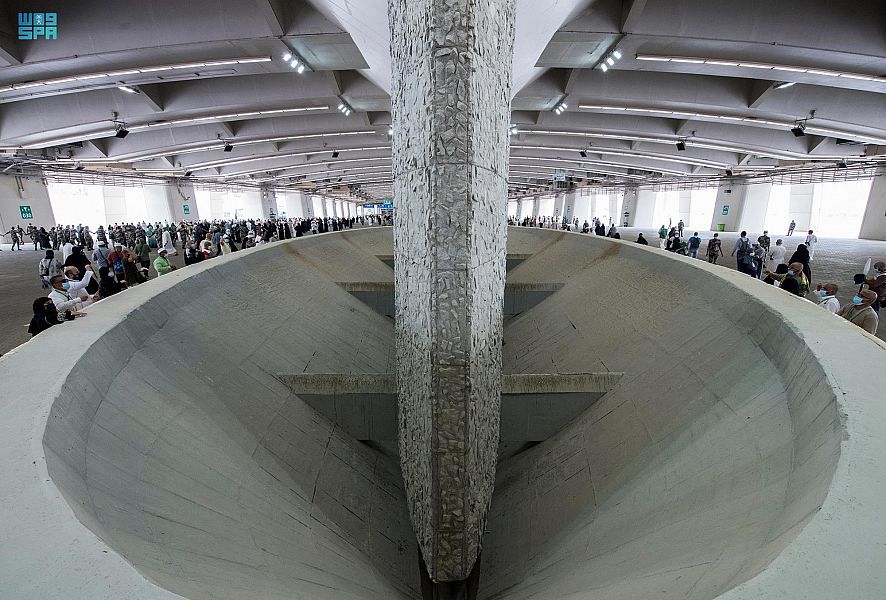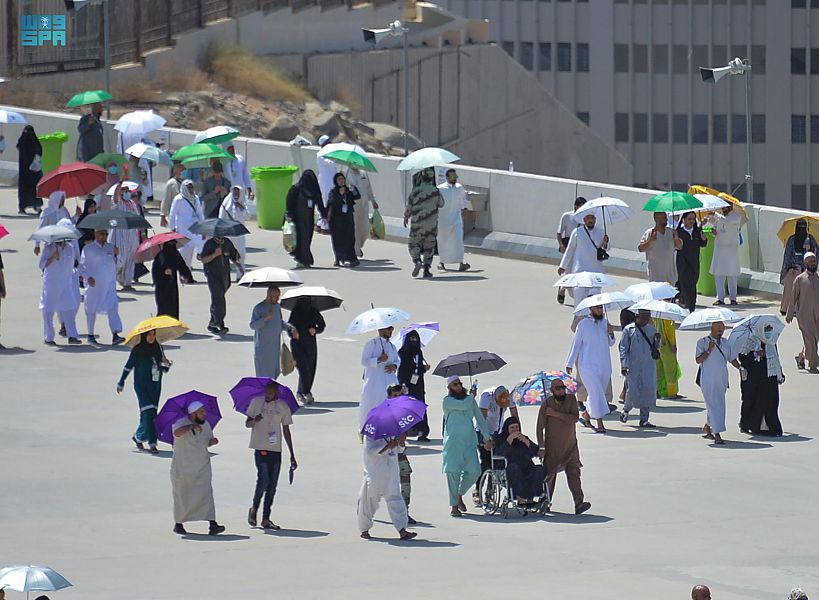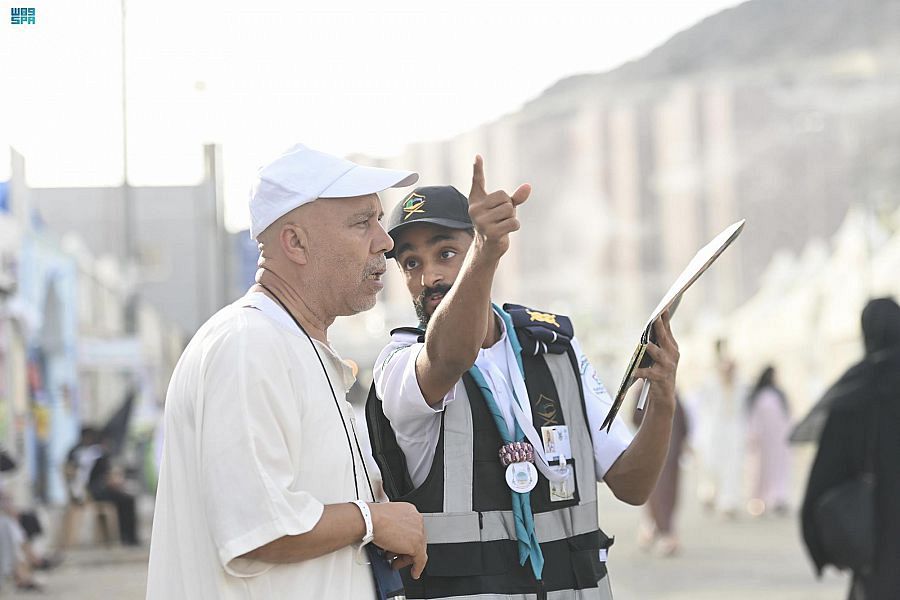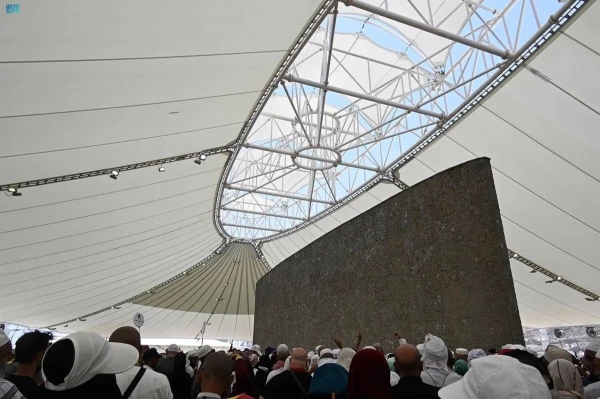
Hajj pilgrims continued performing the ritual of stoning at Jamarat on the first day of the Tashreeq on Monday. They hurled pebbles at all three Jamarat or pillars symbolizing devil on the fourth day of the annual pilgrimage of Hajj and the second day of Eid Al-Adha.
Pilgrims moved in batches in their allotted time for performing the ritual. Upon their arrival at the Jamarat, chanting “Allahu Akbar"" (God is the greatest), pilgrims stoned first at Jamarat Al-Sugra (small pillar), then at Jamarat Al-Wusta (medium pillar) and lastly at Jamarat Al-Aqaba (largest pillar), seven times each.
Pilgrims moved in an orderly and smooth manner from one pillar to the next as they hurled pebbles at the pillars. Multiple lanes were allocated for the smooth movement of pilgrims to the multi-level Jamarat Bridge complex. They prayed after stoning the first two pillars and quit quickly after stoning at the third Jamarat, following the tradition of the Prophet (peace be upon him).
Multiple pathways were designated across various floors of the Jamarat facility to ensure a smooth flow of pilgrims and manage the crowd. This innovative, multi-level structure was engineered to distribute pilgrims efficiently during the throwing ritual. Pedestrian bridges connect the Jamarat to the Mashaer Metro and surrounding pilgrim camps in Mina, facilitating safe and convenient movement.
On the Tashreeq days, the ritual of stoning usually begins afternoon but it was delayed on Monday for a couple of hours following the directive of the authorities due to the extreme hot weather that reached 49 degrees Celsius. Earlier on the day, the Ministry of Hajj and Umrah directed Hajj missions and tawafa organizations not to send their pilgrims to Jamarat Station from 11 a.m. to 4 p.m. under the scorching sun, Okaz/Saudi Gazette has learnt from well informed sources.
The ministry directed that the grouping of pilgrims to the Jamarat shall be rescheduled in accordance with the directives from the competent authorities. This is due to the significant rise in temperatures, which necessitated the deployment of a large number of ambulances around the Jamarat facility to deal with any emergency cases while performing the stoning ritual.
Health Minister Fahd Al-Jalajel also urged pilgrims to avoid peak sun hours from 11 am to 4 pm when performing their remaining Hajj rituals. He urged them to avoid direct sun exposure and stay away from hot surfaces, stressing that prevention is the key.
The ministry’s spokesperson reported that 2,764 cases of heat stress were treated on the first day of Eid. “Pilgrims have undertaken a tremendous journey to perform Hajj,” he said. “Our role is to support them fully. We believe in prevention before treatment, and we urge pilgrims to follow safety guidelines, such as using umbrellas during rituals and staying hydrated.”
The spokesman further reassured the public that the overall health of pilgrims remains positive. No significant public health challenges or disease outbreaks have been reported. The ministry also reminded pilgrims of symptoms of heat stress and sunstroke, including nausea, headache, excessive sweating, and severe sneezing.
Muscle fatigue from frequent movement and walking long distances is another potential concern. To prevent this, the ministry advises pilgrims to rest after completing each ritual, avoid carrying heavy items, wear comfortable shoes, and drink water before performing rituals.
The Holy Sites of Mina, Muzdalifah and Arafat recorded the highest temperatures since the start of the Hajj, reaching up to 49 degrees on Monday. The National Center of Meteorology expected the hot weather would continue on the first day of Tashreeq in Makkah and the Holy Sites in general, coinciding with the pilgrims continuing their rituals.
More than 1.83 million pilgrims are performing the stoning ritual. They proceed to the Jamarat Complex from their camps in Mina on their allotted scheduled time. Pilgrims are reaching the Jamarat on board Mashair Train and buses while pilgrims staying in tents located near the Jamarat walked on foot to the facility.
The ritual of stoning had begun on Sunday, the Day of Sacrifice, by stoning only at Jamarat Al-Aqaba. Stoning at Jamarat is the most repeated ritual of the Hajj. Pilgrims perform the ritual at one Jamarat (Jamarat Al-Aqaba) on the first day of stoning on the Day of Sacrifice, Dhul Hijjah 10.
In the next two or three days, they hurl seven stones each at the three pillars. The five-level Jamarat Complex structure around the three stoning sites allows for a smooth flow of pilgrims who are only permitted to move in one direction throughout the area to prevent congestion.
After performing four main rituals of stoning, sacrificing animals, shaving or cutting hair and performing Tawaf Al-Ifadah and Sai’, pilgrims returned to their accommodation in Mina.
A huge contingent of security forces and health workers have been deployed at the Jamarat Complex to ensure the safety and health of the pilgrims as well as their smooth conduct of the stoning ritual. After Monday’s ritual of stoning, they will spend the rest of the time in prayers and supplications in their tents, and the five-six day rituals of Hajj will come to a close after performing stoning rituals at Jamarat on Tuesday or Wednesday afternoon.











